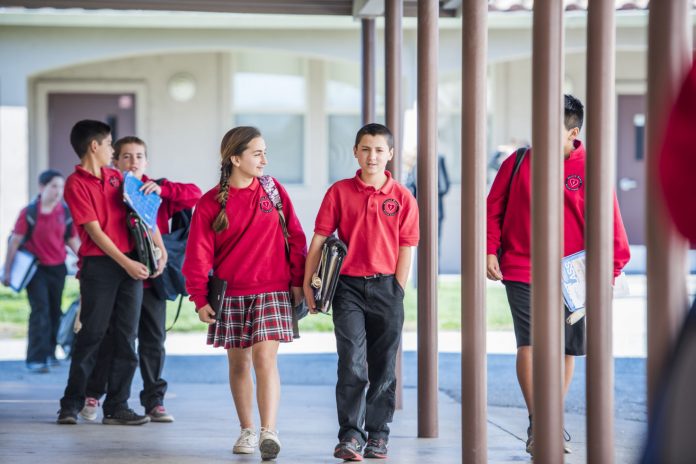
About 125 years ago, W.L. Ludson developed the zipper, the first shipment of asparagus arrived in San Francisco, and a Catholic boarding school named Sacred Heart opened in rural San Benito County.
Lasting 125 years is longer than a human lifespan, which is why some of the school’s families, like some Guerra/Nino members, can track several generations of family through the school.
There’s great-grandfather Anthony Guerra, grandfather Al Guerra, daughter Danielle Nino, and kids Vincent, 11, Elizabeth, 11, Elena, 10, and Molly, 8.
“Well, I think it’s great that it’s still there, and still thriving, and maybe stronger, said Al Guerra, a local businessman. “Things go away. I never thought I’d experience almost 70 years of change. And things don’t last. It’s really great that it’s still here. It’s standing the test of time. That’s a long time.”
During the school’s grandparents’ day earlier this month, the three living generations of family came together to celebrate a school they had all attended as students. The campus is set apart from nearby residences by its characteristic white, steepled church, located on College Street in Hollister.
Guerra credited the school with giving students a well-rounded, Catholic education and letting parents get to know families of their children’s friends.
“I think the school has a good reputation,” he said. “What I like about the school is they require parent participation and so your kids get more of an idea that someone is watching and someone is supporting.”
All four of Guerra’s kids attended the Catholic school. For his daughter, Danielle, the decision to send her kids to Sacred Heart wasn’t hard. Her husband, Rob Nino, also went to Catholic school growing up, though he attended Saint Mary’s in Los Gatos, she said. She chose the school because of its Catholic education, small community and family-friendly environment, she said.
“I wanted to make sure that they learned about God, that they have God in their everyday lives. I want that for them, as they grow older,” she said. “Also, I like the small community of the Catholic schools.”
Since there is just one class of students per grade level, the same kids are together in class each year and it’s “like a little family in itself,” Nino explained.
“They do know a lot about each other,” she said.
Things have changed a bit over the four generations the Nino/Guerra family has attended the school. When Al Guerra attended the campus, there were “several” nuns; when Nino attended, there were “a couple”; but now, there are none, Guerra explained.
Sacred Heart was founded as a boarding and day school under the direction of four sisters, said Principal Marquita Yriarte. At the time, tuition was “fairly minimal,” she said. Today, the school is staffed by lay people, so the site began charging tuition to fairly compensate faculty and staff, the principal said.
Tuition is $5,969 a year for K-5 grade students and $6,167 for 6-8 grade students, with discounts for families attending the parish or sending multiple students, according to the school’s website.
During the 1890s—when the school first opened—it cost $1 a month for day students and $200 a year for boarding school, said Terri Picha, the registrar for the school, as she referenced an article written about the site during its 100th anniversary. Spanish and French lessons were free, Picha said.
“I feel that a business that is a good business stays in business,” the principal said. “Our longevity is a testament to the product we offer the community.”
Changes over the years include increased technology and the addition of a preschool and pre-kindergarten program, the principal explained.
Though the school has changed some to fit the times, much has stayed the same.
“Here at Sacred Heart, we still hold to the foundations of our Catholic faith, which stresses the importance of Gospel values reflected in peace and justice for all,” Yriarte said. “We continue to involve our parent community in partnership as we educate our student body and we continue to support the development of the whole person through rigorous academics, including the teaching of art, music, physical education and world language.”









